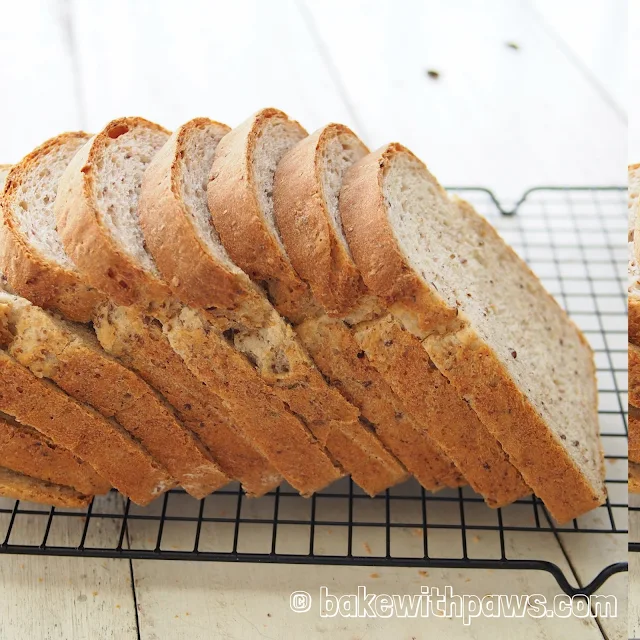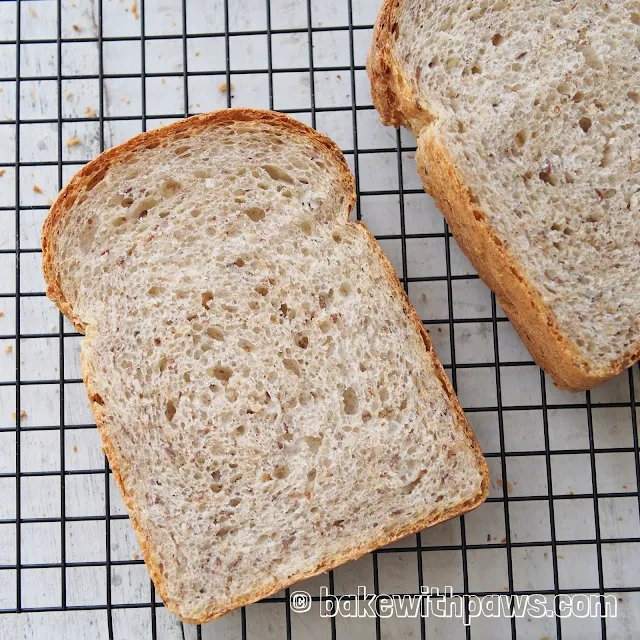Breads (Yeast) - Loaves
Spelt Multigrain Bread
March 07, 2020
| Recipe by Bake with Paws
For this recipe I used 100% spelt flour. The bread turned out quite nice. But, the bread slightly dryer then the bread made from bread flour. However, it is still soft. I have another multigrain bread recipe using bread flour and yudane method, you may click here for the recipe.
Spelt flour does contain some gluten and it works as a substitute for wheat flour or high gluten bread flour. Spelt is an ancient whole grain claimed to be more nutritious and healthier than modern grains.
Spelt flour does contain some gluten and it works as a substitute for wheat flour or high gluten bread flour. Spelt is an ancient whole grain claimed to be more nutritious and healthier than modern grains.
This Spelt Multigrain Bread is a dairy free bread recipe and is ideal for vegans.
Yudane method is quite similar to Tangzhong (water-roux) method. Both methods are scalding method. For the Yudane method, boiling water is used to scald the flour instead of cooking over the fire. Please click here to see the differences between Yudane vs Tangzhong Method.
Yudane method is quite similar to Tangzhong (water-roux) method. Both methods are scalding method. For the Yudane method, boiling water is used to scald the flour instead of cooking over the fire. Please click here to see the differences between Yudane vs Tangzhong Method.
I have other Yudane Method recipes that you may like to try too. Yudane Method Bread recipes.
If you have any questions regarding this recipe or any other post, please leave me a comment in the “LEAVE A COMMENT” link and I will reply you as soon as possible. Do tag me on Instagram @Bakewithpaws if you attempt on this recipe.
How To Make Spelt Multigrain Bread Recipe (Yudane Method)
Yields: 1 loaf
INGREDIENTS:
Yudane:
75g spelt flour
75g boiling water
Bread:
250g spelt flour
65g multigrain (9 grains - brown flax, anthograin wheat, rye, triticale barley, sesame, spelt, quinao and millet)
65g multigrain (9 grains - brown flax, anthograin wheat, rye, triticale barley, sesame, spelt, quinao and millet)
1 1/2 tsp instant yeast
28g brown sugar or honey (I used organic brown sugar)
1 tsp salt
13g extra virgin olive oil
165g - 175g water (add 165g first and reserve the balance to use if too dry)
Utensils:
Pullman pan (20 X 10 X 10 cm) or (8" X 4" X 4")
METHOD:
- Yudane:
- Add spelt flour in a bowl, pour the boiling water and mix well with spatula or spoon.
- Cling film and place in the fridge for at least 4 hours or overnight.
- Take out from fridge 30 minutes before using to return to room temperature.
- Main Dough:
- Blend the 9 grains in a food processor for few second. Keep aside.
- Put all ingredients together with yudane dough (except olive oil) into the bowl of stand mixer. Using the dough hook, knead for 5 minutes (Chef Kenwood mixer, speed 2.5) until the dough comes together. Add in olive oil and continue kneading for another 8 - 10 minutes until the dough comes together, become elastic and tacky but not sticky. I noticed that it is harder to achieve a very thin window pane with Yudane method dough. It could be due to the gelatinization of its starch. It is fine if your window pane is not very thin as long as you have kneaded the dough long enough. During the whole kneading process, I stopped few times to scrape down the dough from the hook to be sure it is evenly kneaded and also to prevent the motor from overheating.
- 1st Proofing
- Let the dough rise in a warm place for 60 minutes or until double in size in a large greased bowl, covered with cling film or kitchen towel.
- Shaping:
- Punch down the dough to release the air. Transfer the dough to a clean floured surface and form into a ball. Roll out the Roll out flat with a rolling pin.
- Fold in both sides to meet in the middle and roll up the dough like Swiss Roll until a log is formed.
- Place dough in the prepared loaf pan.
- Final Proofing:
- Let it rise for another 30 - 45minutes or until the dough reaches slightly above the rim's of the pan.
- Baking:
- Preheat the oven to 190C (top and bottom heat) or 170C (fan-forced) for 15 minutes.
- Bake in preheated oven for 30 - 35 minutes until golden brown.
- Remove bread from oven and let them cool on rack completely before slicing.
GENERAL NOTES:
GLUTEN DEVELOPMENT & WINDOWPANE TEST
Gluten forms when flour comes in contact with water. Hydration of the flour causes the sticky and stretchy protein to form, giving structure to the bread. This makes your bread trap air and rise.
Gluten in dough can be developed by autolyse, resting, kneading or folding.
The windowpane test is used to determine whether the dough has been sufficiently kneaded. By gently pulling the dough (or you may pinch off some dough) and trying to stretch it into a thin membrane. If you are able to stretch the dough paper thin and translucent without tearing, then the gluten is fully developed. However, if you can stretch it without tearing but the membrane is not transparent, then the gluten is not yet fully developed.
However, from my experience not all the recipe can achieve a thin and translucent window pane stage easily. For example low hydration and low fat dough. For such recipes, a reasonable window pane is good enough and it can be left to rest. Gluten will continue to develop while resting. Exercising restraint to not over-knead the dough prevents the gluten from being overworked and broken. Some of you may have experienced the dough breaking during the second proofing. It is because the dough is over kneaded.
The total kneading time for me is usually 15 minutes at low speeds except brioche dough with high fat percentage or dough using liquid fat which usually takes a little longer (maybe 18-20 mins).
From my experience, I found that high hydration dough with high percentage of fat will be easy to stretch and achieve a paper thin windowpane stage.
KNEADING TIME
For kneading, please regard the timing provided as an indication only. It is only meant as a guide. Timing may differ depending on the brand of flour and electric mixer used. The protein content may vary from one brand of flour to another.
FLOUR
The right flour plays a very important role in bread making. To achieve fluffy, soft and light bread, I used Japan High Gluten Flour in most of my bread baking. The protein content is around 12 - 13%.
HYDRATION
The liquid measurement given is also a guide. It is advisable to always reserve some liquid and not add it all in one go. This would give you the opportunity to adjust if necessary. If dough is too dry, add the reserve liquid one tablespoon at a time until the right consistency. This is because each flour absorbs water and hydrates differently.
PROOFING
Please note that the proofing timing may also vary depending on your climate and environment. The humidity and temperature at your place will influence how dough rises.
If you are unable to judge by just looking at the dough, you can do the finger poke test:
- First Proofing:
- Lightly flour or oil your finger or knuckle, gently poke in the centre of the dough then remove your finger. If it bounces back immediately without any indentation then it needs more time.
- If the indentation stays and it doesn’t bounce back or if the dough collapses, then the it is over proved.
- If it bounces back just a little, then the dough is ready to be punched down and shaping.
- Second Proofing:
- Lightly press the side of the proved dough with your finger. If it bounces back immediately without any indentation, it means the dough is under proved and needs more time before baking.
- If the indentation stays and it doesn’t bounce back, it means it has been over proved.
- If the indentation slowly bounces back and leave a small indentation, it is ready to bake.
- There will be a final burst of rising once the bread is placed to bake in the oven and it is called oven spring.
WRINKLE TOP OR SHRINKING
If your bread collapses or gets wrinkled on top after removing from oven, it could be because your dough over proved during the second proofing. Please proof until it rises 80 - 90% in size or is slightly below the rim of the pan.
BAKING TEMPERATURE & TIME
Do also note that the baking temperature and timing provided are what works for my oven and should also be regarded as a guide only. Every oven behaves a little differently, so please adjust accordingly for your oven.
Labels:
Breads (Yeast) - Loaves,





Can I leave out of the sugar? Thanks
ReplyDeleteHi, thanks for reading this recipe. Yes, you can.
DeleteCheers :)